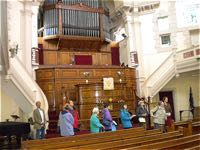
Sidwell Street Methodist Church
Page updated 10th November 2015
 This Methodist church, recently renovated, shines like a beacon at this end of Sidwell Street. Its method of construction was ground breaking at the time and it deserves a mention for that very reason.
This Methodist church, recently renovated, shines like a beacon at this end of Sidwell Street. Its method of construction was ground breaking at the time and it deserves a mention for that very reason.
In 1894, the St Sidwell Methodists purchased a site in upper St Sidwell’s, on a site sandwiched between the rear of the houses in Sidwell Street and Oxford Road. The land which cost £1,600 was for a school hall and classrooms, which could also double for Sunday services. The facility opened two years later, at a cost of £3,500.
The new church
The hall soon outgrew the congregation and some houses on Sidwell Street were demolished, clearing a square site for a new church. It was immediately adjacent to the Sunday School hall. Twenty-one foundation stones were laid on 3 December 1902, for the building. The first stone was laid by the Mayor—after each stone was laid, the person who laid it would place a sum of money on the stone, ranging from £50 down to £10; the total came to £362, an amount that went towards the building fund. One stone was laid to commemorate an earlier gift of £500 from Alderman Reed.
The building in detail
In 1901, architect Frederick J Commin, of Commin and Coles, was commissioned to design a church for this site. His invitation for tenders, attracted one for £9,600 from Paul Cottancin, a French engineer whose ‘ciment arme’ system offered an innovative method of construction. He had already built several ferro-concrete structures in France. Although, this new structure differed from his previous work, the tender was accepted as it was a £1,000 lower than the competition.
The contractors for the church were Westcott, Austin and White,who used many local artisans, while Wippel Brothers and Row installed the heating system, which included a powerful electric fan in the domed roof. The system of construction used steel wires which were threaded through hollow red bricks, into which concrete was poured. In addition, decorative detail was created by casting concrete in moulds. These structures were also threaded onto the steel work. The result, was a light, strong structure. Unfortunately, Cottancin's tender was too modest, and the engineer was bankrupted by the time the building was completed.
Building work commenced in 1902. Constructed of brick and concrete, with some copper roofing, the building has a large square chapel under an octagonal lantern rising to a circular cupola. The whole is richly decorated in an Edwardian Baroque style, with Art Nouveau details. The church had seating for 800. The interior still retains its original fittings, including a screen and doors. The church was opened on the 1 May 1905 by the Rev. F L Wiseman.
There was a large attendance at the opening ceremony, when Mrs. Robert Holman, of Topsham, unlocked the door with a solid silver key, which was provided with a case, the silver plate on which contained the inscription:
"Presented to Mrs. R. Holman. on opening the Wesleyan Chapel, St. Sidwell's, Exeter, May 3rd, 1905."
The key had been presented to Mrs. Holman at a meeting held in the School Chapel by the Superintendent Minister, before the ceremony.
The renovation
After nearly a hundred years the building was dreary and dirty, and little appreciated by most who passed it. In 2005, architects and engineers were engaged to repair and renovate the building, which was fast deteriorating. Water penetration through the roof had caused the encased steel to rust, which penetrated the concrete. Concrete Repairs Ltd were engaged to repair the damage, necessitating a technique of hand modeling the intricate mouldings. Corroded steel bars were replaced with stainless steel reinforcing. The cost of the work was £64,000.
The renovation is striking, and the building’s exterior now almost glows in Sidwell Street. This is a good example of a sympathetic repair and renovation, and thankfully, the church has escaped demolition for student flats.
│ Top of Page │





